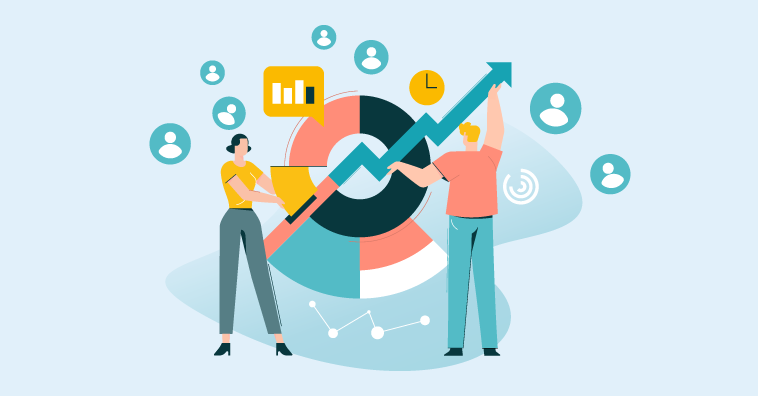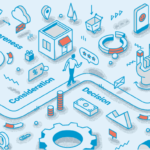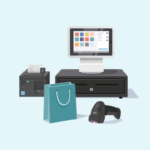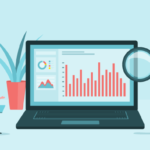What’s the first thing that comes to mind when you brainstorm ways to grow your retail business? Most growth-focused retailers strategize on how to attract new customers. Of course, customer acquisition is key to growth. But, in the quest to increase sales, don’t forget about existing customers.
Returning customers are highly valuable assets that can accelerate retail growth. In fact, when retailers improve their customer retention rate by just 5 percent, they see an increase in profits between 25 and 95 percent. There are two main reasons behind the spike. First, turning an existing customer into a repeat – and loyal – customer costs up to six times less than getting a prospective customer to make their first purchase. Second, on average, returning customers spend nearly one-third more than new customers, which can make achieving your growth goals much easier.
Based on those types of returns, targeting existing customers to drive growth makes sense. But the idea that growth only comes from new customers runs deep. The reality is that only 18 percent of retailers focus on customer retention strategies.
When – and how much – to focus on retaining customers
A customer retention strategy is made up of actions retailers take to turn one-time buyers into repeat purchasers. But, before exploring the best retention strategies, it’s important to understand how much retailers should focus on customer retention.
Newer retailers need to focus on bringing traffic into their stores. That means putting a heavier focus on customer acquisition strategies while still laying the groundwork for retention. Think of it as a 70/30 split – 70 percent focused on getting people to visit and make an initial purchase and 30 percent on giving them a reason to return. (More on that later!) Established retailers with a base of existing customers should shift the balance to 40/60. The need to attract new customers is always important, but in this case, slightly more emphasis on keeping existing customers engaged and purchasing can really fuel growth.
The age of the retail business isn’t the only factor to consider. The type of business you’re in should also determine how much emphasis to put on customer retention. For example, a coffee shop has the potential for high purchase frequency, so it should focus more on getting customers to return the next day. At the other end of the spectrum, a furniture or electronics store will have lower purchase frequency but higher product value, so they may want to split their focus more evenly between acquisition and retention.
Determining the right balance for your retail business requires tracking key metrics so that you’re able to optimize the value of returning customers. Monitor your repeat customer rate closely. This tells you how many customers are making more than one purchase – and how well your retention efforts are working. (Obviously, the higher, the better when it comes to customer retention!) You should also keep an eye on customer purchasing patterns, such as the average purchase amount and purchase frequency. The good news is that an integrated point-of-sale (POS) system makes it easy to capture, automate, and track these data points.
Related: What Your Customer Retention Rate Tells You About Your Retail Business
6 ways to turn customer retention into retail growth
Once you’re monitoring key retention metrics, you can turn your attention to creating and executing specific programs and promotions to strengthen your customer relationships and increase repeat sales.
Be there for your customers.
Today’s shoppers seek a mix of in-person and online experiences. That puts delivering an omnichannel customer experience at the top of the retention list. Retailers with strong omnichannel experiences have an average customer retention rate of 89 percent compared to a 33 percent average for those with weak omnichannel strategies. Leverage an integrated POS system to bring together your brick-and-mortar, e-commerce, and mobile shopping experiences – as well as your behind-the-scenes inventory management, customer relationship management, and reporting.
Related: How to Optimize Omnichannel Retail and Keep Customers Coming Back
Go the extra mile.
Customer experience is the biggest potential differentiator in the highly competitive retail environment. Empower your retail associates to go above and beyond to provide personalized and memorable interactions with your customers. Your POS system can help you provide the tools associates need, including mobile POS capabilities, accessible customer profiles, and point-of-sale checkout ease.
Inspire – and reward – loyalty.
Give first-time customers a reason to return by creating a loyalty program that rewards repeat purchases through discounts, exclusives, and other incentives. Today, retailers can design creative and customized rewards programs that fit their customers and align with business objectives. An integrated POS system makes setting up and managing customer loyalty programs easy with integrated tracking of qualifying activities, seamless customer relationship management, and targeted marketing.
Related: How to Create a Customer Loyalty Program that Works
Create a community.
Successful retailers do all of the above, but they don’t stop there. They engage customers in events and experiences that drive long-term loyalty, such as classes, product previews and demonstrations, and subscription services. These types of experiences not only strengthen connections between customers and retailers but also help to generate positive word of mouth that attracts new customers. The top POS systems help retailers with everything from tracking attendance or collecting fees through creating an online event calendar, communicating with customers, or selling course materials and kits.
Win customers back.
Don’t leave customer retention to chance. Capture customer emails as part of your checkout experience and create email marketing messages that keep them engaged and give them reasons to return. As part of this type of customer engagement strategy, tap into your POS system’s purchase history to identify customers who haven’t purchased in a while, and create tailored outreach messages and promotions that prompt them to return.
Give thanks.
A simple thank you message goes a long way. Sending a personalized thank you note after a customer makes a purchase reinforces their positive shopping experience and shows them that you value their business. This can be one of the easiest strategies to implement – especially when collecting email addresses is a standard part of your customer profiles. For first-time customers, consider including a discount offer for their next purchase.
POSIM is a point-of-sale and inventory management system that helps retailers ramp up customer retention and drive growth. Contact us for a demo and discover what’s possible with POSIM.












